• T H E S H O W C A S E •
Home Buy Services Resources Contact
National
Parks of the West
-
by Kerry L. Thalmann
NOTE: this exhibit appeared in March 2000. Click here to visit the current showcase.
All other
exhibits: Click
here to access
Please
click on one of the following thumbnails to see a larger
image. Use the Back button in your browser to return to this
screen and select another image.
Note: For those not familiar with the 4x5 format, I have included the approximate 35mm equivalent focal length for each image.
Grand
Canyon of the
Yellowstone 4x5
Format - 135mm lens
Mount
Gould from Swiftcurrent
Lake Links: 4x5
Format - 210mm lens
Moraine
Lake Link: 4x5
Format - 135mm lens
Clearing
Winter Storm - The Kolob
Canyons
Fall
Colors - Zion
Canyon
Bryce
Canyon from Inspiration
Point
Colorful
Hoodoos
Approaching
Storm - Delicate
Arch
Balanced
Rock
Canyonlands
from Dead Horse
Point
Angel
Arch
The
Great Gallery
The
Mittens and Merrick
Butte
Morning
Light from Mather
Point
Sand
Dunes
Clearing
Winter Storm - El
Capitan
Bridalveil
Falls
Sunset
- Ruby Beach

Yellowstone National Park, WY, MT, ID
Yellowstone is the where it all started - the
world's first National Park. It is still one
of the crown jewels of the US National Park
system. In additional to outstanding scenic
and thermal features, it is also a haven for
wildlife. This photograph was taken looking
down canyon from the brink of the Lower Falls of
the Yellowstone River.
Links:
Official
NPS Yellowstone
Website
Expanded
NPS Yellowstone Website
(35mm equivalent focal length ~38mm)

Glacier National Park, MT
Only tiny remnants of the glaciers remain, but the
landscape they created is spectacular. Rugged
mountain peaks, deep U-shaped valleys and crystal
clear lakes are all the work of glaciers. In
1932, the governments of the United States and
Canada joined together to create Waterton-Glacier
International Peace Park - the world's first
International Park.
Official
NPS Glacier
Website
Expanded
NPS Glacier Website
(35mm equivalent focal length ~59mm)
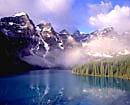
Banff National Park, Alberta, Canada
Canada's first National Park was established in
1885 and originally named Rocky Mountains National
Park. In 1930, the name was officially
changed to Banff National Park. The famous
view of Moraine Lake and the Wenkchemna Peaks
adorned the back of the Canadian twenty dollar bill
for many years.
Official
Parks Canada Banff Website
(35mm equivalent focal length ~38mm)

Zion National Park, UT
The Kolob Canyons are not as well known as Zion
Canyon, but they are no less spectacular.
Located in the extreme northwest section of the
park, they are not accessed via the main Zion
Canyon road, but from a short dead end road off
I-15. The Kolob Canyons are also at a higher
elevation than Zion Canyon, which increases the
likelihood of snow in the winter. After a
couple wet soggy December days in Zion Canyon, I
decided to head up to the Kolob Canyons for an
afternoon of photography. I got there just as
the clouds were clearing to reveal the red rock
formation draped in a fresh coat of white snow.
Link:
Official
NPS Zion Website
4x5 Format - 210mm lens
(35mm equivalent focal length ~59mm)
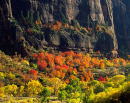
Zion National Park, UT
Zion Canyon in the Fall is a magical place.
This image features red and orange maple trees at
the base of the Great White Throne and golden
cottonwoods along the Virgin River in the
foreground. In most years, the maples and
cottonwoods do not reach peak color at the same
time. The first week of November, 1998 was an
exception. Both were peaking together and the
weather was perfect. Throw in the always
spectacular setting and you have all the right
conditions for some exceptional photography.
If you happen to visit Zion in the Fall, be sure to
bring plenty of film.
Links:
Official
NPS Zion Website
4x5 Format - 450mm lens
(35mm equivalent focal length ~127mm)

Bryce Canyon National Park, UT
I can think of no better place to photograph at
sunrise than from the rim of Bryce Canyon.
The main amphitheaters in Bryce face east to greet
the rising sun, and the first rays of light make
the orange formations absolutely glow with
color. Inspiration Point, along with Sunrise
Point, are my two favorite overlooks for sunrise
photography in Bryce Canyon National Park.
Link:
Official
NPS Bryce Canyon
Website
4x5 Format - 90mm lens
(35mm equivalent focal length ~25mm)
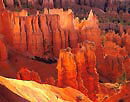
Bryce Canyon National Park, UT
After photographing the sunrise from the rim, I
like to hike down among the hoodoos (as the
colorful pinnacles are called). The strong
backlighting makes them appear to be lit from
within. This image was taken from the Navajo
Loop Trail a few hundred yards below Sunset
Point.
Link:
Official
NPS Bryce Canyon
Website
4x5 Format - 210mm lens
(35mm equivalent focal length ~59mm)

Arches National Park, UT
Arches National Park is said to have the largest
concentration of natural rock openings in the
world. Delicate Arch is the most
famous. It's likeness was even featured on
Utah license plates at one time. The classic
image of Delicate Arch is taken on a sunny day in
early Spring with the snow covered La Sal Mountains
in the background. It truly is a beautiful
image, but on this particular day, I hoped for
something a little different. As I parked my
truck at the trailhead, I could see the storm
moving in from the south. I thought for sure
I'd get soaked with rain on the hike back to the
truck, but I didn't care, I wanted to photograph
the arch with the approaching storm in the
background. As luck would have it, not only
did I get the image I had hoped for, but I stayed
completely dry. It poured in Moab, a few
miles to the south, and there were even a few water
drops on the hood of my truck when I got back
to the trailhead. Sometimes mother nature can
be incredibly generous.
Links:
Official
NPS Arches Website
Expanded
NPS Arches Website
4x5 Format - 135mm lens
(35mm equivalent focal length ~38mm)

Arches National Park, UT
In addition to the famous arches, there are many
other interesting rock formations in Arches
National Park. Balanced Rock is one of the
more dramatic. It is shown here at sunset
with the La Sal Mountains in the background.
Originally shot as a 4x5, I prefer this image
cropped to a more panoramic format (to eliminate
excess blank sky and dark, shadowy foreground).
Links:
Official
NPS Arches Website
Expanded
NPS Arches Website
Cropped 4x5 Format - 360mm lens
(35mm equivalent focal length ~101mm)

Canyonlands National Park, UT
Technically, this image was not taken within a
National Park. It was taken from the overlook
at Dead Horse Point State Park which is perched
high above the Colorado River and the winding path
it has carved through Canyonlands National
Park. In addition to this spectacular view,
Dead Horse State Park also has an excellent
campground with easy access to the Island in the
Sky section of Canyonlands National Park.
Links:
Official
NPS Canyonlands
Website
Expanded
NPS Canyonlands
Website
Utah
State Parks Dead Horse Point
Website
5x7 Format - 150mm lens
(35mm equivalent focal length ~31mm)

Canyonlands National Park, UT
Canyonlands is one of my favorite National
Parks. It's really like three parks in
one. The Island in the Sky section is the
high tableland (with many spectacular overlooks)
between the Green and Colorado Rivers. The
Maze is the remote, rugged section to the southwest
of the rivers, and the Needles section lies to the
southeast of the rivers. Although neighboring
Arches National Park is more famous for dramatic
natural spans, Canyonlands also has many equally
impressive openings. Mesa Arch in the Island
in the Sky is a classic sunrise shot. Angle
Arch and Druid Arch in the Needles section are two
of my favorites. These magnificent arches,
combined with spectacular destinations like Chesler
Park, and many fine examples of prehistoric rock
art and ancient ruins, make the Needles section of
Canyonlands an outstanding location for combining
hiking and backpacking with a little
photography.
Links:
Official
NPS Canyonlands
Website
Expanded
NPS Canyonlands
Website
4x5 Format - 135mm lens
(35mm equivalent focal length ~38mm)
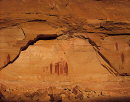
Canyonlands National Park, UT
Not only does our National Park Service protect
outstanding scenic areas and wildlife habitat, they
also protect and preserve many significant historic
and prehistoric sites. The Park Service
preserves our nation's heritage in sites like
Boston National Historic Park, where you can visit
Paul Revere's house and the Old North Church, and
Independence National Historic Park in
Philadelphia, where you can see the Liberty Bell
and visit Independence Hall, where both the
Declaration of Independence and our Constitution
were created. The legacy of ancient
civilizations is also preserved in sites such as
Mesa Verde National Park and Hovenweep National
Monument. The remote, detached Horseshoe
Canyon section of Canyonlands National Park was set
aside to protect the Great Gallery. This huge
panel of ancient rock art is the largest, most well
preserved example of the Barrier Canyon style of
pictographs. Using current techniques, it is
not possible to determine exactly when these
pictographs were painted, but most estimates are
between 2,000 to 4,000 years ago (some estimates as
high as 8,000 years ago). No matter how old
they are, the pictographs of the Great Gallery are
remarkably well preserved and very impressive (the
largest figures are over seven feet tall).
Links:
Official
NPS Canyonlands
Website
Expanded
NPS Canyonlands
Website
4x5 Format - 150mm lens
(35mm equivalent focal length ~42mm)

Monument Valley Navajo Tribal Park, UT/AZ
Even if you've never been there, you're sure to
recognize Monument Valley. From the time it
was first featured in the 1938 classic
Stagecoach, Monument Valley has
represented the quinessential western landscape
featured in countless movies and commercials.
Many people incorrectly assume that Monument Valley
is part of US National Park Service. It is
not. It is a Navajo Tribal Park, straddling
the Utah/Arizona border. This image is the
classic view from the visitor center. The
visitor center, Mitten View Campground and the 17
mile self guided loop road are all open to the
public. To visit the more remote sections of
the park, you must hire a local Navajo
guide.
Link:
Navajo
Nation Parks and Recreation Department Monument
Valley Website
4x10 Format - 210mm lens
(35mm equivalent focal length ~30mm)
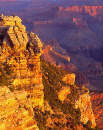
Grand Canyon National Park, AZ
It is impossible to capture the immensity of the
Grand Canyon in a photograph. Even witnessing
it first hand, it's hard to fully appreciate
exactly how much dirt and rock the Colorado river
has carried away over the millennia to create this
wondrous chasm.
Links:
Official
NPS Grand Canyon
Website
Expanded
NPS Grand Canyon
Website
4x5 Format - 360mm lens
(35mm equivalent focal length ~101mm)

Death Valley National Park, CA
Death Valley is a land of extremes. Elevation
in the park ranges from -282 feet at Badwater, the
lowest point in the western hemisphere, to 11,049
feet at the summit of Telescope Peak. In the
Summer, temperatures at the park's lower elevations
often top 120 degrees, with a North American record
of 134 degrees recorded on July 10, 1913.
Death Valley is also a vast area of stark
beauty. It has long been a popular tourist
destination, but Death Valley has only recently
gained National Park Status. On October 31,
1994, the boundaries of Death Valley National
Monument were expanded to enclose over 3.3 million
acres and the name was officially changed to Death
Valley National Park. Thus creating the
largest US National Park outside of Alaska.
Death Valley has several dune fields. This
image was taken as the first rays of morning light
grazed the dunes near Stovepipe Wells.
Link:
Official
NPS Death Valley
Website
4x5 Format - 360mm lens
(35mm equivalent focal length ~101mm)

Yosemite National Park, CA
It is often said that Yosemite is both overcrowded
and over photographed. Still, it is
definitely worth a visit and is high on my list of
favorite places to photograph. John Muir
described it as "the incomparable valley", and
Yosemite Valley is truly one of the most
spectacular landscapes I have ever seen. Yes,
overcrowding can be a major problem - if you
confine your visit to Yosemite Valley during the
popular Summer months. To avoid the crowds
and take advantage of some special photographic
conditions, I recommend visiting Yosemite during
the off season. If you come during the winter
months, be prepared for winter travel conditions,
and some very rewarding photography. This
image was taken on a March morning two years ago
after twelve inches of fresh snow had fallen the
previous night. I spent the entire morning
photographing in Yosemite Valley, and saw almost
nobody else out and about until after 11:00am when
most of the snow had melted. Not bad for such
an overcrowded park.
Links:
Official
NPS Yosemite
Website
Expanded
NPS Yosemite
Website
4x5 Format - 110mm lens
(35mm equivalent focal length ~31mm)

Yosemite National Park, CA
From Carlton Watkins in the 1860s through the
legendary Ansel Adams, Yosemite has long been a
prime destination for nature photographers.
While setting up your camera in Ansel's tripod
marks may not be the most original thing in the
world, the light and weather in Yosemite Valley is
ever changing, making it possible to create your
own unique Yosemite images. In my
photography, I try to capture special places at
special moments in time. This image is my
version of the classic shot of Bridalveil Falls and
Cathedral Rocks. A fast moving May storm lead
to this opportunity. I arrived at the parking
area at Tunnel View to find the rock wall facing
the Valley lined with photographers standing
shoulder to shoulder. To get away from the
mob scene, I walked a couple hundred yards up the
Inspiration Point Trail. This gave me a
slightly different perspective with some nice trees
in the foreground. As the sun began to break
through gaps in the cloud cover, I waited
patiently for the exact moment when the direct
sunlight illuminated only Bridalveil Falls and the
surrounding rock face. The result is a slight
variation on a very familiar subject.
Links:
Official
NPS Yosemite
Website
Expanded
NPS Yosemite
Website
4x5 Format - 210mm lens
(35mm equivalent focal length ~59mm)

Olympic National Park, WA
With a unique combination of glacier clad mountain
peaks, low elevation temperate rain forests and
some of the most remote stretches of wilderness
beach in the lower 48, Olympic National Park
contains unparalleled scenic diversity. As a
sunset symbolizes the end of the day, I chose this
image of a sunset from Ruby Beach to conclude this
Showcase. Thank you for stopping by, I hope
you enjoyed this exhibit and that it inspires you
to visit your National Parks and support
legislation and park policy that will further
protect and preserve these very special places for
the enjoyment of our children and grand
children.
Links:
Official
NPS Olympic
Website
Expanded
NPS Olympic
Website
4x5 Format - 150mm lens
(35mm equivalent focal length ~42mm)
Note:
For best viewing, set your monitor to High Color or True
Color (Thousands or Millions of Colors on MacOS) and
1024x768 pixels. These images have been carefully prepared
with a Gamma of 2.2 using the BruceRGB color space. This
should work well with high-quality Windows monitors. If you
are a MacOS user, set your Adobe Gamma control panel to
"Windows Default" or, at the last resort, choose the sRGB
calibrated profile in the Color section of your Monitors
control panel.
Please
note: All images featured in this showcase
Copyright ©Kerry L. Thalmann, all rights reserved.
These images are protected by U.S. and international
copyright laws and may not be used or reproduced without
permission. For licensing information, or to order prints,
please contact Kerry L. Thalmann at photos@thalmann.com
About
the Exhibit:
The
idea that a nation would set aside large tracts of land to
preserve and protect them for the enjoyment of future
generations has often been called "the best idea America
ever had". This idea became a reality with the signing
of the Yellowstone National Park Act of 1872. For the
first time, a country's federal government had created a
park "for the benefit and enjoyment of the people."
Canada soon followed suit with the creation of Rocky
Mountains National Park (later re-named Banff National Park)
in 1885. In 1957, the Navajo Nation in the Four
Corners region of the American Southwest created their own
Parks and Recreation Department, and their first National
Park - Monument Valley Navajo Tribal Park.
Links:
US
National Park Service Official
Website
Parks
Canada Official Website
Navajo
Nation Parks and Recreation Department Website
In the 128 years since the creation of Yellowstone National Park, the United States Park System has grown to include 55 National Parks, 72 National Monuments, 74 National Historic Sites, 10 National Seashores, 4 National Lakeshores, 9 National Wild and Scenic Rivers, plus many more sites of natural and historic significance. All total, the United States National Park service currently manages 378 sites encompassing 80.7 million acres and ranging in size from 0.02 acre (Thaddeus Kosciuszko National Memorial, PA) to 13.2 million acres (Wrangell - St. Elias National Park and Preserve in SE Alaska). It certainly was a good idea.
Living in the West provides easy access to many of our most spectacular National Parks. Over the past several years, I have been fortunate enough to visit and photograph in most of the western parks. This Showcase features some of my favorite images made during those visits. I especially enjoy visiting the National Parks during the "off season". Not only are the parks much less crowded, but the photography is often better as well. The most dramatic photographs are often the result of what most people would consider "bad" weather. To photograph Yosemite Valley or Zion under a fresh coat of snow requires waiting out a winter storm. I also love the dramatic light that often follows or precedes storms as they sweep across the red rock landscapes of the Southwest. I have truly enjoyed creating these images and welcome the chance to share them with you. I hope you enjoy them as well.
To see some more examples of my work, please visit my web site at: http://www.thalmann.com
and my previous PhotoTripUSA Pacific Northwest Showcase
I welcome your comments on this exhibit. Please send them to me at: photos@thalmann.com
Find photos of the Colorado Plateau in Land
of the Canyons,
the Photo Trip USA landscape photography guide book.